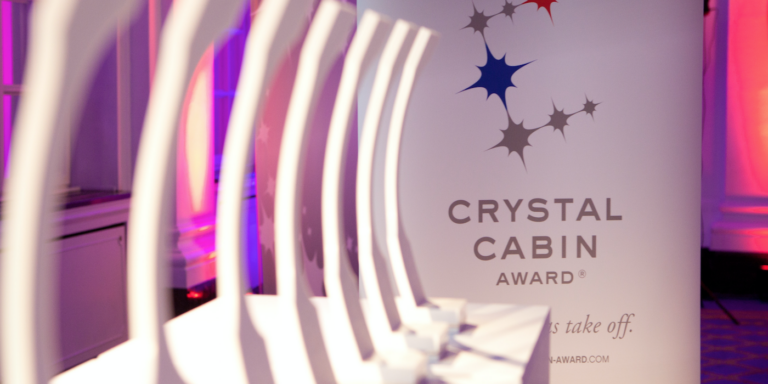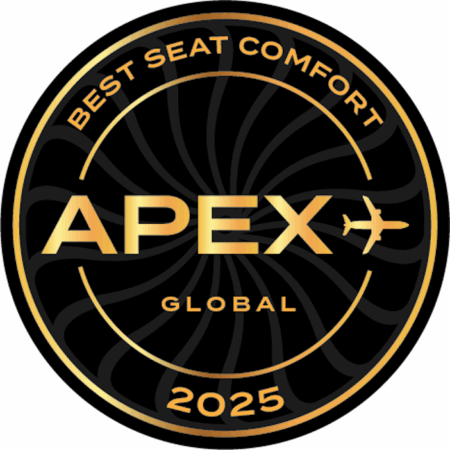Tonight saw the winners of the 2023 Crystal Cabin Awards announced, at an event in Hamburg’s Chamber of Commerce. The winners span a range of ideas and technologies, from a step-change in economy-class air travel, to inflight wi-fi, air quality technology, and ways to make aviation more environmentally sustainable.
First, a little background about the awards
The Crystal Cabin Awards are the world’s most respected prize for aircraft cabin innovation, and they have have been running since 2007. The selection process is thorough: this year the judging panel, made up of 27 industry experts, made an initial evaluation of more than 80 entries, with a voting round deciding the 21 finalists (three in each of the seven categories). Yesterday (5th June) saw the judging panel meet in Hamburg to explore each finalist in depth, with detail gained through presentations, product demonstrations and evaluations, and interviews.
There were some tough decisions to be made during the day, with the winners eventually decided upon by vote across the seven categories: Cabin Concepts, Cabin Systems, Health & Safety, IFEC & Digital Services, Material and Components, Passenger Comfort, Sustainable Cabin, and University. So who are the 2023 Crystal Cabin Award winners?
Cabin Concepts
Winner: Air New Zealand Economy Skynest
The Cabin Concepts category typically attracts the most widespread interest around the world, as it is the space that passengers can experience on their flights today or in the near future. Many airlines and companies have created great inflight experiences, but that isn’t quite enough to earn a Crystal Cabin Award. The category contenders need to demonstrate why their product is innovative, and distinct in the market.

The winner certainly meets the brief. Next year will see Air New Zealand launch its new ultra-long-haul services, enabled by fuel-efficient Boeing 787-9 Dreamliners. The launch routes will be non-stop services between Auckland and the USA (New York and Chicago). The four or so hours usually involved in airport transfers on the way will be saved, but the flights will still take around 16 hours – palatable or even enjoyable in the swanky Business Premier cabin, but in standard economy? Ouch.
However, with Economy Skynest, passengers in economy and premium economy will have the option to get some proper sleep in a bunk bed. The Skynest unit contains six full-length, lie-flat Skynest pods, arranged in a V-shape to be space-efficient and to give privacy in the head area. Each pod will be in excess of 200cm (79in) long and wider than 58cm (23in) at the shoulder area.
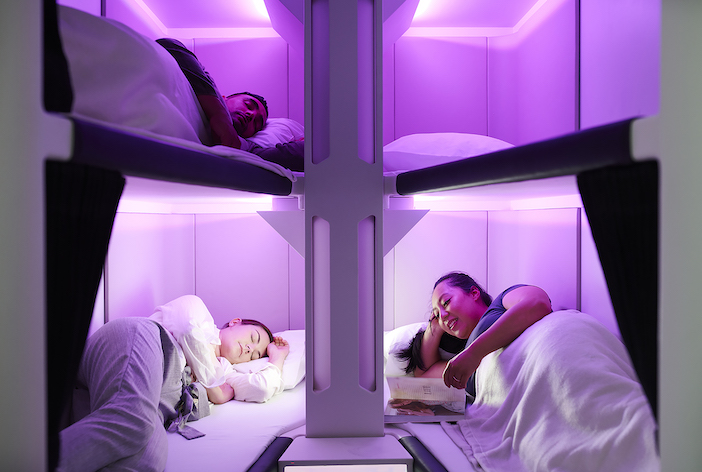
You can get a feel for the Economy Skynest with this video tour.
The bunks can be booked in four-hour slots, with a slot costing around NZD$400-600 (depending on the dynamic pricing). Sure, an eight-hour slot would be great, but four hours has been chosen as it is long enough for restorative sleep, while being short enough to offer availability to more customers – and to help ensure it won’t tempt business-class passengers to downgrade their ticket.
The notion of bunks may seem simple to people outside of aviation, but the design involved five years of research and development, carried out at Air New Zealand’s Hangar 22 innovation centre in Auckland, with the input of more than 200 customers. Air New Zealand’s head of airline programmes, Kerry Reeves, says the scale of the challenge in developing the Economy Skynest and working through its certification with the necessary regulators has been “immense”.
the potential to be a game-changer for economy class travellers on all airlines around the world”
However, he describes the economy-class dormitory as “a prize worth chasing, and one that we think has the potential to be a game-changer for economy class travellers on all airlines around the world.” Reeves is referring to the chance that, in time, flyers may be able to experience the design on other airlines, as Air New Zealand is considering licencing the design, as it does with the Economy Skycouch.
Runners up:
Lufthansa Allegris
The Lufthansa Group put up a strong contender with Allegris, a huge €2.5 billion (US$2.65bn) project, most of which is being spent on aircraft interiors upgrades throughout its long-haul aircraft fleet, from first class to economy. The programme will see around 27,000 seats installed across the group’s new widebody aircraft, including Boeing 787-9s, Airbus A350s and Boeing 777-9s, and retrofitted on the Boeing 747-8s already in service. The new cabins will be rolled out from autumn 2023, with 14 type of seat, including seven types of business class seating, so there is an option to suit almost any personal need. You can find out more in our May issue HERE.
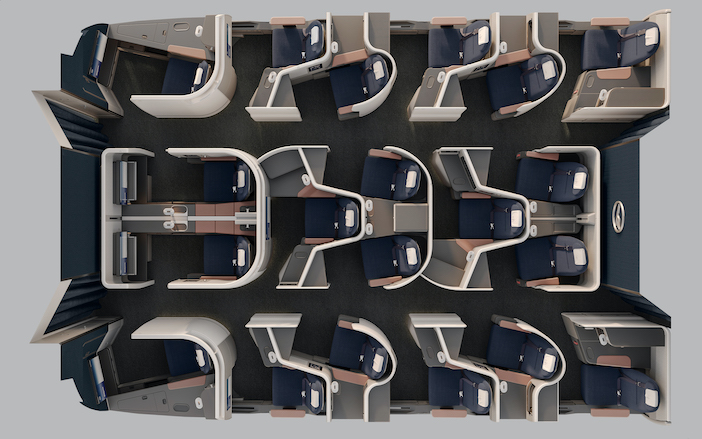
Diehl Crew Rest
The third entry could be welcome news for crew on long-range narrowbody flights. The integrated Crew Rest Compartment for Single-Aisle Aircraft by Diehl Aviation is a foldable flat rest space for crew in single-aisle jets, which uses the crew jump seats as a support. A well-rested crew make for a safer and more enjoyable passenger experience.
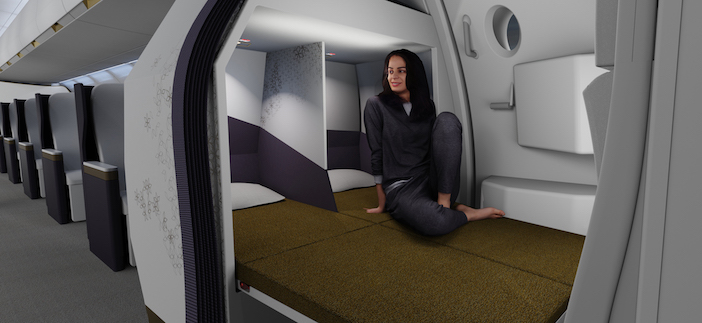
Passenger Comfort
Winner: Collins Intelisence
Ticket price and route networks are the most important considerations for many travellers when choosing an airline, but travel comfort is an important differentiating factor for airlines. This category of the Awards recognises advances in improving passenger comfort within the cabin, encompassing many elements such as seats, lavatories, stowage bins and lighting.
Collins Aerospace describes its InteliSence intelligent cabin experience as an intuitive, integrated intelligence system that can provide cabin crew and maintenance technicians with insights and predictions to enhance the premium cabin service and passenger experience and make airline operations more efficient.
For example, the system’s deep-learning AI software, edge-computed video analytics and sensor technology can be used to observe passenger interactions with objects within a first or business-class suite, such as drinks glasses, plates, and entertainment screens, creating data that is collected and communicated in real-time to service teams. With this information, crew can ensure that passengers are offered food or drink refills, their plates collected or issues attended to, without them having to ask, bedding is laid quicker, and any equipment faults are remedied rapidly. In short, the system can enable crew to meet passenger needs before they are asked.
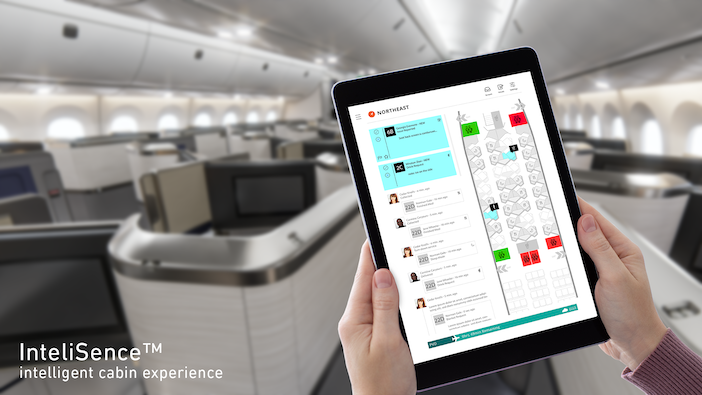
Sounds good, but does this mean passengers are being watched by cameras? In short, no: only the system is analysing movement, and the vision sensor neither stores nor shares photographic images. Intelisence extracts relevant information captured by the vision sensor, makes behavioural predictions, and sends that information to the crew’s existing digital interface as a simple data point. Passengers are free to opt out of the service via their airlines’ app or on-seat IFE screen.
The system’s predictive analysis allows airlines to optimise on-board catering provision based on past passenger preferences and can also help optimise power efficiency by automatically adjusting in-seat light usage based on factors such as seat occupancy and screen usage, or whether they need lights to read a book or magazine.
Runners up:
Adient Aerospace – Ascent Front Row Suite
Many airlines are introducing single-aisle aircraft on long-haul routes, as a way to right-size operations when passenger numbers do not justify a widebody being used. When those airlines offer a first class or top-level business class cabin in their widebodies, they are keen to ensure that their narrowbody inflight experience is not inferior. This is where Adient Aerospace’s Ascent Front Row Suite comes in, a new business-class seat design for the first row in the business cabin, which offers an elevated experience.
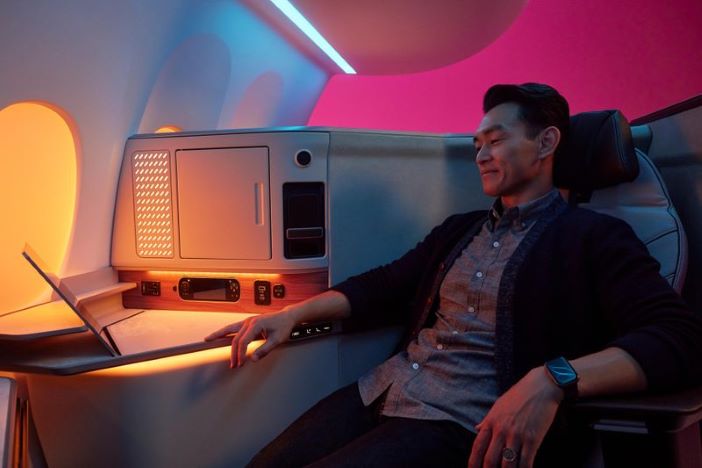
The most noticeable change is that the overhead bin is removed to create a lot more vertical space, enabled as a bag can be stowed beneath the companion seat. The occupant sits facing the window and enjoys extra comforts including a desk, library, and a rather snazzy pop-up minibar. Perhaps just one tweak would make the experience even better: an infill cushion or similar to span the gap between the main seat and the companion seat when in bed mode, to create a wider sleeping surface.
The enlarged Airbus A350 Airspace cabin
Looking at the bigger picture, the updated Airbus A350 Airspace cabin is designed to offer more space, choice and flexibility for a wider cross-section of revenue passenger areas. Some alterations to the A350 cabin architecture have created additional room for larger galleys, a new flight-crew rest compartment in the upper crown area, a larger forward lavatory (good news for passengers with reduced mobility) , and more seating options for airlines.
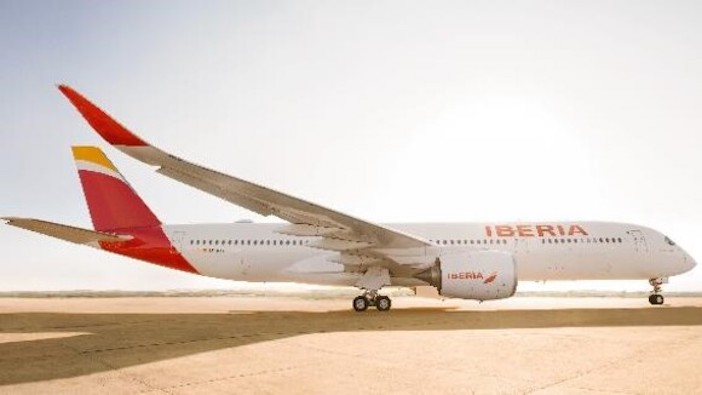
Perhaps the potential should have been realised earlier, but the enhanced A350 cabin is here now, and it launched with Iberia. You can find out more about how the cabin was expanded in our feature HERE.
Health & Safety
This category recognises ideas that enhance the health and safety of passengers and crew in the aircraft, whether by minimising security problems or safety hazards, or addressing onboard health, hygiene or physical well-being issues. This category took on particular importance during the Covid-19 pandemic, as passengers’ expectations of cabin health and safety rose to new levels. This year saw all three finalists in the Health & Safety category focus on improving cabin air quality.
Winner: Teledyne ACES
Aircraft cabin environmental quality incidents can include anything from reports of fumes, smells, smoke, mist, haze or other contaminants. Most aircraft today do not have equipment installed onboard that can automatically and comprehensively monitor air quality in the cabin and flight deck. When an air quality incident arises, understanding what happened is largely based on human perceptions, not objective data.
Teledyne’s ACES (Aircraft Cabin Environment Sensor) includes devices that are installed in the cabin and flight deck, which continuously sense and monitor air quality. Those devices employ laboratory-grade sensors that record key environmental parameters, including data on airborne particulates from 0.3 to 10 microns in size, carbon dioxide, carbon monoxide, ozone, volatile organic compounds and several other parameters. For example, aircraft operators can record particulate and volatile organic compound data to help ensure the effectiveness of the aircraft’s HEPA filters.
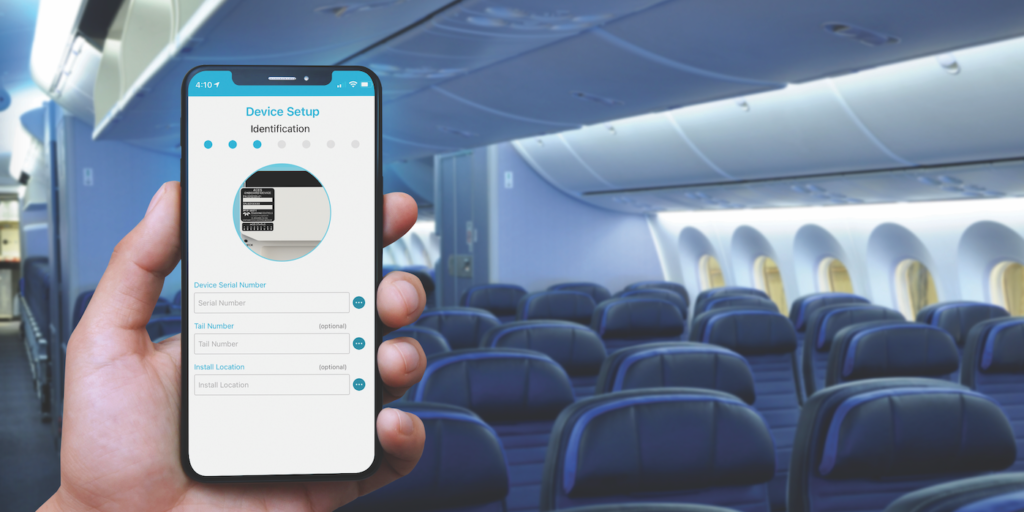
The data recorded by the ACES onboard units is automatically transmitted to the ACES cloud service portal for immediate processing and analysis. By gaining access to accurate data for every flight, aircraft operators can continuously verify the air quality in the cabin. If an air quality event occurs, instead of making assumptions based on human perceptions, they have objective data at their disposal to troubleshoot and diagnose the issue, make an informed decision on the proper remedy, and validate the corrective action.
By monitoring trends on specific aircraft, they can also identify and address potential emerging issues to help prevent future incidents.
Runners up:
Collins Aerospace – Pothos
Collins Aerospace was in the running with Pothos, a cabin air ioniser designed to deodorise cabin air to levels that mimic, and even exceed, clean, natural outdoor conditions. The compact unit can be integrated into any enclosed space – including Environmental Control System ducts and direct passenger air systems. The demonstration was impressive – check it out if you are at Aircraft Interiors Expo this week.
CTT Systems Pure
Improving customer wellbeing was also the focus of CTT Systems’ contender, with its Humidification Onboard Pure Air system adding an active carbon filter to its existing humidification technology. CTT’s core work is in making the aircraft cabin – the driest environment in the world – more humid, and with this filter it can also clean that environment from fumes and ozone introduced via bleed air.
IFEC & Digital Services
This category comprises the fast-growing range of digital products and services in the aviation industry. Entries can include inflight entertainment and connectivity (IFEC) solutions such as seatback displays, antennas and wi-fi, passenger apps, and even entire software solutions that create a smart and connected cabin. Entries need to prove their technological superiority against competing products in this tough-fought sector.
WINNER: AirFi LEO Connectivity
AirFi, in cooperation with Iridium, won with its Low Earth Orbit (LEO) system. The system, when launched, will use a pen-sized antenna housed in the window frame to create an IP connection to the Iridium Certus LEO system, enabling passengers to connect to services such as WhatsApp and iMessage, the aircraft to access ACARS transmissions, and airlines to validate credit card payments. One aspect which impressed the judging panel is the relatively low cost of the system (NDAs forbid me to share), which can open up connectivity options to operators of small fleets and to low-cost carriers with tight margins.
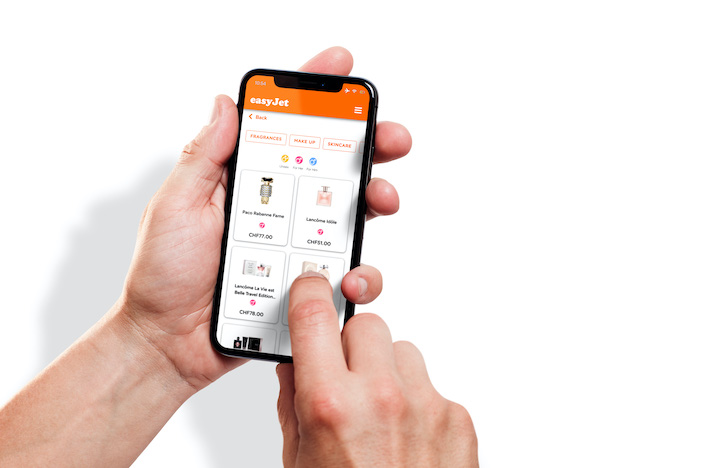
Runners up:
Airspace Link HBCplus
Airbus was again in the running, with its Airspace Link HBCplus, a new high-bandwidth satellite connectivity solution offered as both a line-fit and retrofit option, which enables airlines to connect to a choice of Managed Service Providers via a new agnostic terminal and radome.
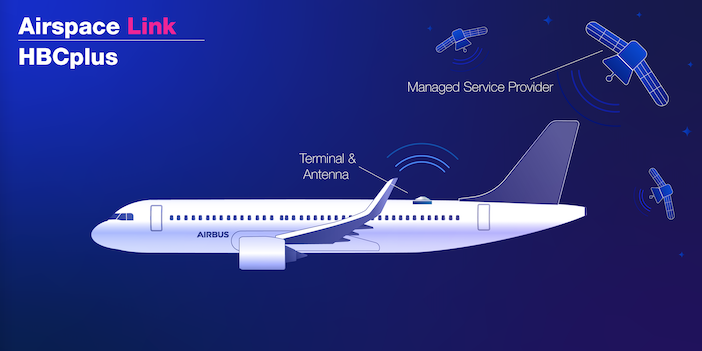
Skyted
Skyted made it to the finals with an invention that integrates a wi-fi connection into a facemask engineered to dampen the noise of the wearer’s speech. The aim of the design is to combat the increased cabin noise generated by the proliferation of video calls, which will worsen with future 5G connectivity in the aircraft cabin. There is also potential to tie in the design with brands, which may wish to engage with a captive audience. The masks, developed in cooperation with PriestmanGoode, Airbus Development, the European Space Agency Accelerator Program and ONERA, will first be implemented in the rail sector this year, with aviation due to follow next year.

Sustainable Cabin
Sustainability is a hot topic in every sector, but aviation is under immense pressure. The industry has made a commitment to become zero-emission within the next 30 years, and the cabin plays a major role, representing 10-20% of the potential overall improvements. The cabin has long been a space where sustainability has been an indirect concern, as airlines look to reduce weight to save on fuel usage. Now suppliers and airlines are looking deeper into their product choices to ensure they are not just lightweight, but sustainably made.
Winner: Lantal Deep Dyed Carpet
Carpeting may not sound like the most exciting advance in the cabin, but Switzerland-based Lantal has poured its heart, soul and millions of Euros into developing a milestone in the world of aviation carpet, with an innovative digital manufacturing process.
Conventional aviation carpets are made using a yarn-dyeing process, which can be slow and energy intensive. If an airline wants a complex and colourful carpet pattern, that can increase weight and cost, and add risk in meeting all airworthiness requirements. Lantal’s new digital technology enables more lightweight carpets while maximising design freedom and customisation, and the carpets are manufactured in a water, CO2 and waste-efficient production processes. Even better, samples and orders can be delivered to clients in days rather than several weeks.
Lantal explains the process in THIS VIDEO.

The company has been bold with this innovation, which has involved five years of R&D, and equipment investments. Bear in mind that while many suppliers – Lantal included – were hit hard by the restrictions on the airline industry during the pandemic, Lantal doubled down its commitment to sustainability and increased its R&D spending. Deep Dyed Carpet has been a labour of love for Lantal.
Runners up:
Airbus – BioMat Sidewall Panel
Airbus was in the running with the BioMat Sidewall Panel, a thermoset resin produced from industrial biomass by-products. The sidewall has been developed in cooperation with Mitsubishi Chemical Group MCG and CTC GmbH, and the partners say that, when used with recycled carbon fibre, the resin eliminates the need for virgin carbon fibre.
Diehl Aviation – Cabin Lining with Integrated Vacuum Insulation
Diehl Aviation has engineered a cabin lining developed specifically to save valuable cabin energy. The ultra-thin sandwich composite with integrated vacuum insulation serves as an insulating material for the cabin lining. In comparison with conventional insulation materials, says Diehl, these materials are five to ten times more effective, providing protection against heat loss, thus reducing energy consumption while also taking up less space.
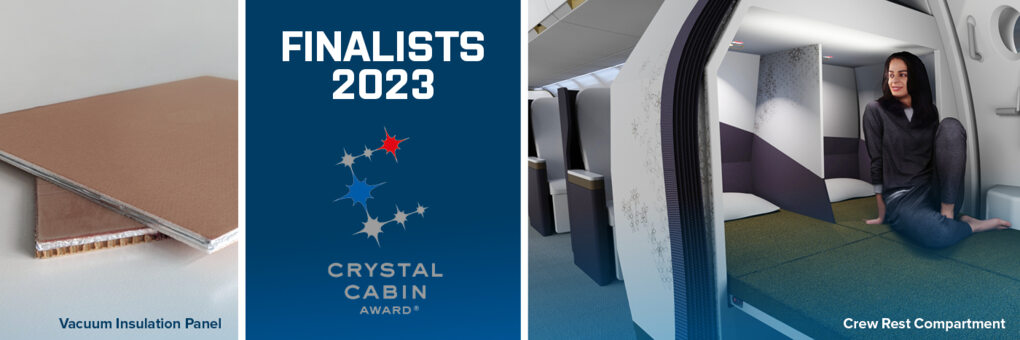
Cabin Systems, Materials and Components
This category structure of the Crystal Cabin Awards has been amended this year, with the Cabin Systems category combined with the Materials and Components category. This category comprises new cabin products that bring benefits to airlines, such as seat structures, galleys, lavatories, trolleys, air conditioning, electrical systems, waste & potable water systems, acoustics and more.
WINNER: Thales Avionics Onboard Data-Center (ODC)
Thales’ Onboard Data Center (ODC) is an IT architecture which uses a system of ‘blades’ that share storage and computing capabilities. Thales says its ODC brings web-based technologies onboard the aircraft for the first time and increases storage space by up to 10-times compared with existing IFE servers. For passengers this means more entertainment available onboard, and reliably so.
The ODC features six patented technologies. Its hyperconverged architecture revolves around individual blades that support multiple functions. These blades share storage and compute capabilities, resulting in a large aggregated storage space. Each blade can be replaced or upgraded depending on the airlines’ needs.

Software is smartly distributed and redounded across blades to optimise onboard resources in real-time. In the event of one or two blades shutting down, service remains up and running without any impact on the passenger experience. The Onboard Data Center’s availability reaches 99.99%.
The ODC’s web-based technologies improve software and content deployment processes, and enable the virtualisation of the entire software stack, removing the need for tests on physical labs. The ODC is also claimed to enable software and content deployment at the click of a button – taking less than 12 hours across an entire fleet.
Runners up:
Collins Aerospace – Q-Tech
Collins Aerospace was in the running with Q-Tech, an acoustic dampening metamaterial engineered to make cabins quieter. Applied strategically as a replacement for traditional honeycomb-core panels, Collins says the material can reduce noise transmission in the cabin from engines, galleys and other passengers, across a range of frequencies.
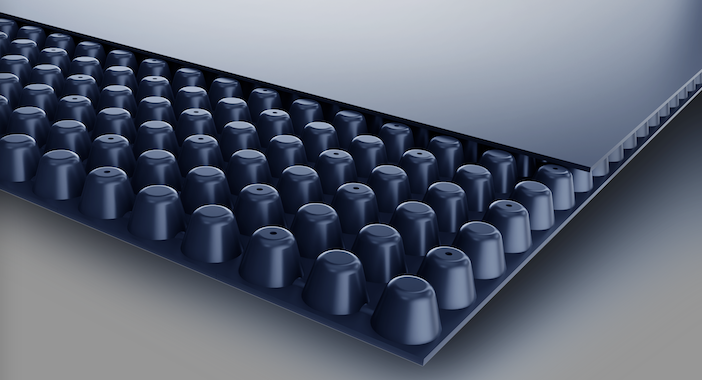
Q-Tech is made of highly flexible interconnected bulb-shaped arrays, and Collins says that its tests have shown it can reduce noise transmission in the cabin by 10-times when compared to a standard double-wall panel. The company claims there is no weight penalty to fitting the panels. Field tests will show if jet noise is preferable to the noise of other passengers in the tube.
J&C Aero – Jump Seat Duo
Cabin accessibility for passengers with reduced mobility (PRMs) is an important topic, and the Jump Seat Duo could offer a solution – and one that also saves valuable cabin space. This dual-purpose module integrates a foldable wheelchair within the crew jump seat, which crew can quickly deploy to assist PRMs, if required. The Awards judging panel is very keen to see accessibility innovations, but a few implementation queries saw the jump set drop down the rankings in this category.
University
The university category is always interesting, giving tomorrow’s passenger experience professionals a chance to shine. The students are given a little more leeway to think beyond the constraints of today’s aviation regulations, giving them more freedom to demonstrate their creativity and ingenuity with clean-sheet designs and unusual approaches for the passenger experience. The creativity is tempered a little by their experienced university mentors, which for this year is mostly Prof Dr Peter Vink, chair of the Delft University of Technology’s faculty of Industrial Design Engineering. All three finalist entries were from this university in The Netherlands, so naturally Peter had to abstain from judging this category.
It is the first time we have seen see one university dominate this category, and other institutions should not feel that Delft has a monopoly in this sector: they have just had a good year. We still want to see entries from creative minds around the world in next year’s Awards.
So this year the question is not which university will win, but rather which student team.
Winner: Lightweight Aircraft seating – Delft University of Technology
The Lightweight Aircraft Seating Concept by Maartje Ballemans and Thomas Hogeveen is an ultra-light seating fixture inspired by the biological form of the human spine, which uses netting as a seat fabric to reduce overall seat mass. The students worked with Embraer to devise a new lightweight, comfortable and sustainable seat design for short/medium distance flights by using Fused Deposition Modelling to print the TPU cushioning. This method enables a cushion with different gyroid infill percentages to be made, which supports the human body where needed. The students say that by using this technique, no extra weight is used – only what is necessary. TPU does not need a flame-retardant coating, so the materials can be fully recycled at the end of life.
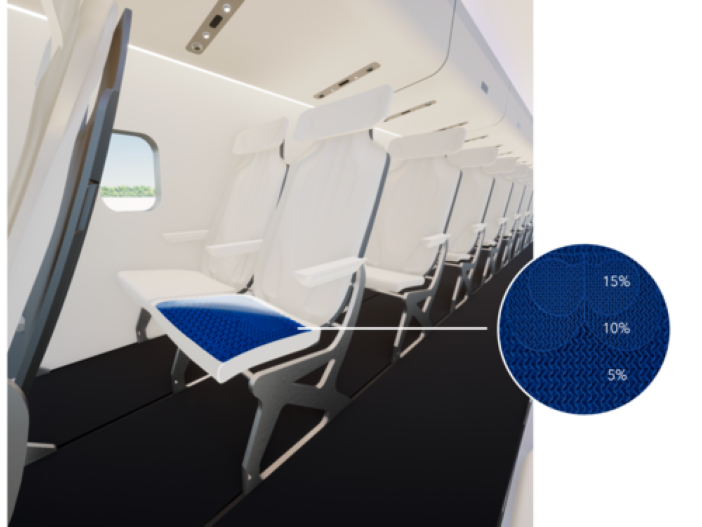
Runners up
Alba Seating Concept
Rens Kierkels, Floris Priester. Daantje Vogels, Daan den Hollander, Maria Sofia Clercy Lao and Max Nijhuis designed a 3D-printed cushion that optimally supports the human body to provide better seating comfort in a lightweight and sustainable product. The Alba concept is a fully netted seating design shaped to the human spine for comfort, while also being lightweight, at a projected total weight of 7.5kg/pax, while being 17mm thinner than the industry-leading seat and consisting of only two aviation certified, recyclable mono materials. The team say the design can pass initial force-testing and other seating requirements, showing that a fully netted design is achievable short term, with an incredible optimisation potential long term.
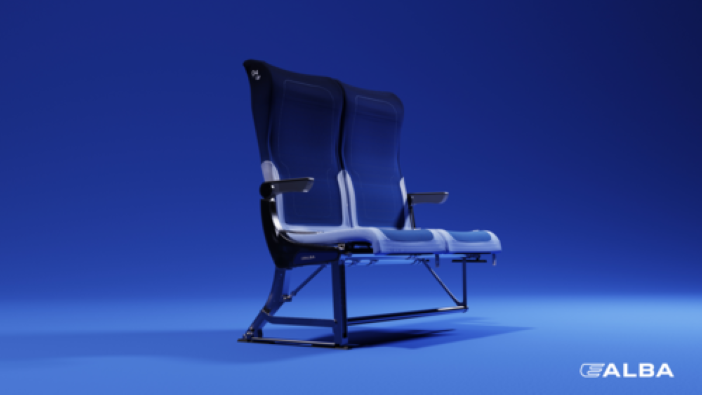
Horus
Jayneel Kiran Soni, Mrinal Chaudhury, Arabella Van Lookeren Campagne, Reina Swinkels & Yujing Cai worked in cooperation with Embraer to devise Horus, a different approach to lightweight seating designed for use on hydrogen-powered aircraft from 2030 and beyond. Such aircraft will require lightweight but strong components in the interiors to minimise. The approximate calculated weight of the designed and prototyped seat is 6.1kg.
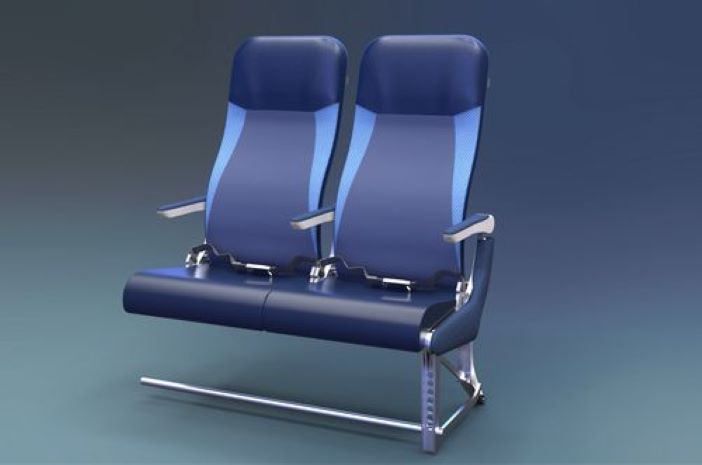
On a final note…
That wraps up the 2023 Crystal Cabin Awards. If you have something to say about them, you may wish to send a blog or vlog (you can reach me at adam.gavine@markallengroup.com). And of course, if you have a great launch or concept coming up, get in touch with the CCA team – you might just be a winner next year.


